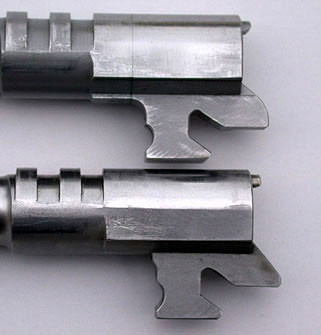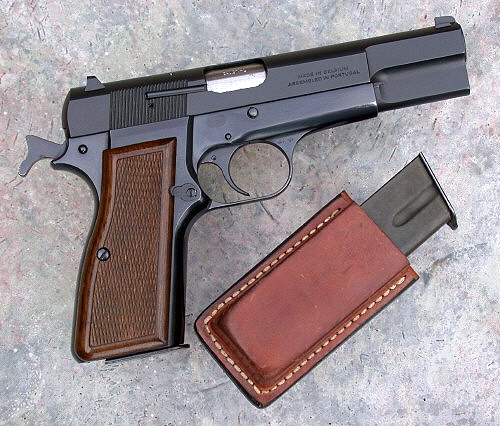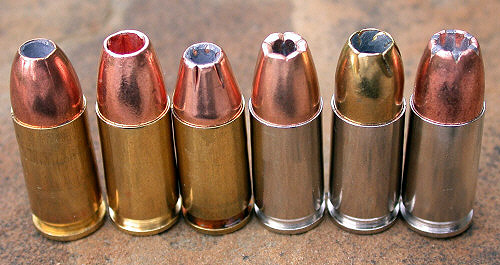9mm Hi Power ReliabilityThis is a question that pops up on the gun forums regularly and one that I have been asked on many occasions. It may be phrased in different ways such as, "Is the Hi Power reliable with hollow points? I've heard that they only feed ball reliably," or "Is the Hi Power as reliable as a Glock?" Some ask if it is reliable enough for self-protection. Others ask how it rates next to the old 1911.
Let's take a look at this issue as much without bias as possible and based on first-hand observations.
The question concerning "only ball ammo being reliable" in the Hi Power stems from the older Hi Powers, which have the old humped feed ramp. These definitely could have "indigestion" with other than FMJ round nose ammunition, not all but some. With the advent of the Mk II Hi Power in the 1980's, FN changed the feed ramp to a "straight" design and since that time, Hi Powers are reliable with about any JHP I've tried. All of the Mk III pistols I've tried have also been reliable with high-performance ammunition.

Shown are two 9mm Hi Power barrels from BarSto.
The top has the humped barrel and closely resembles the FN factory bbl of humped design that was common in Hi Powers preceding the Mk II. The bottom barrel has had the hump removed and appears the same as the current straight ramp factory Hi Power barrels. If one is going to have a humped bbl's feed ramp made into a straight one, care must be taken to insure that most of the work is done at and below the hump. We do not want to remove any more steel than is necessary at the rear of the chamber. Improperly done, this can lead to insufficient case support, never a good thing. (The bottom bbl is an early BarSto of one-piece construction. The top bbl was made later and is of the usual two-piece design as can be seen by the small line where the two parts are joined. Factory Hi Power barrels are of the two-piece design. I have never had a problem with either after tens of thousands of rounds. Neither can I see any difference in accuracy. For more on two-piece barrels, click on the link:
http://www.hipowersandhandguns.com/TwoPieceBarrels.htmIn the earlier 9mm Hi Powers, Mec-Gar was not the OEM magazine manufacturer. Factory magazines often did not hold the cartridge at much of an upward angle. This didn't really matter with FMJ round nose military type ammo, but it did not help those of us trying to shoot blunt JHP's.
I have seen the simple substitution of a current Mec-Gar magazine turn a stuttering classic Hi Power with the humped ramp into a most reliable Hi Power using JHP's. This does not always work, but frequently it solves the problem.
The suggestion that the 9mm Hi Power is only reliable with FMJ ammo is not necessarily true. The Hi Power in this picture is of the current Mk III design. Nothing has been done to enhance reliability because nothing at all has been necessary. This one, as well as several others, has proven to be utterly dependable with every JHP I've tried weighing at least 100 grains. I have found no factory JHP in either standard or +P weighing 115-gr. or over that the Mk II or Mk III will not feed. I suppose that there could be individual examples of the gun that don't, but on the whole I believe that Hi Powers having the current straight feed ramp are not particular.

Every Mk II and Mk III pistol I've tried has feed expanding ammunition of varying LOA and bullet shape extremely well.
It is also frequently parroted that the 9mm Hi Power will not work reliably with the "heavy-weight" 147-gr. JHP's favored by some. I have not found this to be true. Though the only hollow points I've tried in this weight range have been from Remington, Speer, and Winchester, there have been exactly zero problems. Such has held true whether I was using a factory standard 17-lb recoil spring or slightly stronger 18.5-lb spring from Wolff.
The main culprit I've seen in current Hi Powers being less than reliable with any type of ammunition has been weak extractor springs. It has been my experience that the Hi Power requires stout ones. If you have a Hi Power that is failing to extract and eject fired cases, this may very well be the problem and is where I would begin looking. Press the rear of the external pivoting extractor inward toward the slide with your thumbnail. If it moves easily, the extractor spring is too weak. When I've experienced such problems (rare indeed), I've replaced this spring with an extra power one from Wolff and the problem disappears. Sometimes the front "pad" on the backside of the extract needs to be filed down a very few thousandths to solve the problem, but almost always simply replacing the spring does the trick. Before replacing either the spring or working on the extractor, check and make sure that the extractor claw is not chipped or broken. If such is the case, simply order a new one.
I have also been asked if the buffers I use (Buffer Technology's products) decrease reliability. I have not noticed any decrease in reliability.
For those interested in the Buffer Technology shock buff, go here:
http://www.hipowersandhandguns.com/Buffer.htmIn over 3 decades of shooting Hi Powers regularly, I have seen but two that had broken ejectors. If you are suffering ejection problems and the extractor and spring are not suspect, you might inspect the ejector to see if the tip is broken. If it is, replace it but I personally believe that this is very rare.
Sadly, what is unfortunately not rare seems to be a lack of maintenance by either the uneducated or the lazy. Let me explain. For over a decade I've been an instructor for my state's concealed carry program. Firearm qualifications are part of the process. On a fairly regular basis, we see both 9mm and 40-caliber Hi Powers on the firing line. The vast majority of the time, they function flawlessly but on three occasions, Hi Power shooters had reliability problems and on three occasions, their Hi Powers had not been cleaned or lubed in years; they were dry as the proverbial bone! On these same three occasions, a drop of oil on each barrel lug and a drop in the slide rails solved the problem. The Hi Power is definitely a time and battlefield-proven sidearm, but even normally dependable firearms need at least a minimum of maintenance. FWIW, in the three cases of neglect just mentioned, the firearm did not malfunction (usually failure to eject) every single shot. It would normally fire three or more cartridges between malfunctions. Don't let this happen to you; maintain your firearms be they Hi Powers or something else. (One of the badly neglected Hi Powers was a barely shot, never cleaned "T-series." I believe that is probably more than neglect and simply has to be some sort of a sin!)
Now and then, I get emails concerning how a fellow's Hi Power simply is not working with handloaded ammunition. Once again, failing to extract and eject is the usual problem. In each instance, the load was simply too light. The Hi Power's mainspring is rated at 32-lbs, heavier than on most 9mm (or .40) pistols. This is to both insure super-reliable primer ignition and slow rearward slide velocity. Add to that the normal 17-lb recoil spring (for 9mm; 20-lb for the forty) and it becomes clear that the Hi Power is not set up from the factory for light loads. They just don't have the "hootus" to move the slide rearward enough to cock the hammer, eject the fired case, and then strip another cartridge from the magazine and chamber. A general rule of thumb I've found to be true with the 9mm Hi Power is for handloaded ammunition to have a muzzle velocity of at least 1020 to 1050 ft/sec with 115-gr. bullets. Some will operate fine at slightly lower velocities, but every single Hi Power I've shot will work fine with this as it comes from the factory. If a person is bound and determined to shoot really light handloads in their 9mm Hi Power, a reduced power recoil spring is probably the solution. I have not tried this because I simply don't shoot light 9mm loads so I cannot provide any first-hand observations here.
It is no secret that I use both the buffer and the Wolff conventional 18.5-lb recoil spring in my 9mm Hi Powers. My guns' mainsprings are the standard 32-lb from the factory. I've had no problems with standard pressure ammunition or +P with this arrangement, but have noted that some folks do. If the heavier recoil spring is not working for you, go with the factory standard. If you shoot standard pressure loads, the factory 17-lb spring will work fine. If you shoot a goodly number of +P loads, I'd go with the 18.5-lb recoil spring. Sometimes a gun that wasn't working with the 18.5-lb recoil spring when new will after a couple of thousand shots.
This covers the primary causes for stutters in what is usually a very dependable handgun.
For those who might be interested, the greatest number of shots I've fired between internal lubing and cleaning has been just over 700. The gun was running fine then, but I couldn't stand it any longer and gave it a good cleaning and lube job.
In my long-term observation, the Hi Power remains one of the most proven reliable automatic pistols on earth and if one is not, the solutions mentioned here should transform it into one. Most will be from the get-go.
Best.





